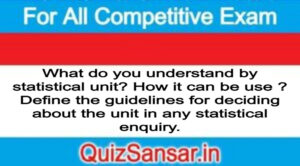
What do you understand by statistical unit? How it can be use ? Define the guidelines for deciding about the unit in any statistical enquiry.
What do you understand by statistical unit? How it can be use ? Define the guidelines for deciding about the unit in any statistical enquiry.
Ans.
Statistical Units and it to be Used
A well defined and identifiable object or a group of objects with which the measurements or counts in any statistical investigation are associated is called a statistical unit. For example, in a socio-economic survey the unit may be an individual person, a family, a household or a block of locality. A very important step before the collection of data begins is to define clearly the statistical units on which the data are to be collected. In a number of situations the units are conventionally fixed like the physical units of measurement such as metres, kilometres, kilograms, quintals, hours, days, week etc., which are well defined and do not need any elaboration or explanation. However in many statistical investigations, particularly relating to socio-economic studies, arbitrary units are used which must be dearly defined. This is imperative since in the absence of a clear cut and precise definition of the statistical units, serious errors in the data collection may be committed in the sense that we may collect irrelevant data on the items, which should have, in fact, been excluded and omit data on certain items which should have been included. This will ultimately lead to fallacious conclusions.
Requisites of a Statistical Unit
The following points might serve as guidelines for deciding about the unit in any statistical enquiry :
1. It should be unambiguous: A statistical unit should be rigidly defined so that it does not lead to any ambiguity in its interpretation. The units must cover the entire population and they should be distinct and non-overlapping in the sense that every element of the population belongs to one and only one statistical unit.
2. It should be specific: The statistical unit must be precise and specific leaving no chance to the investigators. Quite often, in most of the socio economic surveys the various concepts/characteristics can be interpreted in different variant forms and accordingly the variable used to measure it may be defined in several different ways. For example, in an enquiry relating to the wage level of workers in an industrial concern the wages might be weekly wages, monthly wages or might refer to those of skilled labour only or of day workers only or might include bonus payments also. Similarly prices in an enquiry might refer to cost prices, selling prices, retail prices, wholesale prices or contract prices. Thus in a statistical enquiry it is important to distinguish between the conventional and the arbitrary definitions of the characteristics/variables, the former being the one prevalent in common use and shall always remain same (fixed) for every enquiry while the latter is the one which is used in a specific sense and refers to the working or operational definition which will keep on changing from one enquiry to another enquiry.
3. It should be stable : The unit selected should be stable over a long period of time and also w.r.t. places i.e., there should not be significant fluctuations in the value of a unit at different intervals of time or at different places because in the contrary case, the data collected at different times or places will not be comparable and this would mar their utility to a great extent. The fluctuations in the value of money at different times (due to inflation) or in the measurement of weights at different places (due to height above sea level) might tender the comparisons useless. Thus, the unit selected should imply, as far as possible, the same characteristics at different times or at different places.
4. It should be appropriate to the enquiry : As already pointed out earlier, the concept and definition of arbitrary statistical units keep on changing from enquiry to enquiry. The unit selected must be relevant to the given enquiry. Thus, for studying the changes in the general price level, the appropriate unit is the wholesale prices while for constructing the cost of living indices (or consumer price indices) the appropriate unit is the retail prices.
5. It should be uniform: It is essential that the unit adopted should be homogeneous (uniform) throughout the investigation so that the measurements obtained are comparable. For example, in measuring length if we use a yard on some occasions and metre on other occasions in an investigation, the observations obtained would be confusing and misleading.






